Importance of National Safety and Quality Health Service Standards in the Australian Health System Assignment Help
Explain the evolution of National Safety and Quality Health Service Standards the Australian health system and provide a written reflection on how it is positioned to improve health outcomes within an overall healthcare governance system.
Save top grade using Importance of National Safety and Quality Health Service Standards in the Australian Health System Assignment Help solution service of expertsminds.com
Introduction
Healthcare services cover a broader area withinthe societal development, as it is directly connected with the public health aspects. From the past few decades, people suffer from different critical physical and mental health emergencysituations, due to the presence of complicated and unhealthy lifestyle patterns. Therefore, it becomes essential to align the safety and quality healthcare-service standards and protocols during handling of the critical health issues. This assignment is mainly based on the concept of National Safety and Quality Health Service Standards in Australia, through analyzing the standards and identifying the areas of health service improvement.
Concept of National Safety and Quality Health Service Standards in Australia
The National Safety and Quality Health Service Standards, developed by NSQHS Australia, contain a set of clinical measurements, in order to deliver qualified and safe healthcare services for the entire societal population. The NSQHS Standards are applicable to all types of healthcare services. Through applying the standards, the healthcare practitioners focus on proposing evidence-based strategical improvements, for dealing with the gapped or uncovered areas of the current Australian healthcare system. Besides this, as per the report of Australian health ministry department, application of NSQHS Standards could ensure the improvement of patient health outcomes (NSQHS Standards, 2019).
A number of areas are covered under the NSQHS Standards, which are as follows-
• Governing the Quality and Safety for the Australian health service systems
• Creating a partnership with consumers
• Applying medication safety and HAI prevention strategies
• Identifying patients and matching of different healthcare service procedure
• Performing clinical handover
• Managing blood, blood-related products, and pressure injury areas
• Prevention of falls and related risk factors
• Recognition and respond to a certain level of health deterioration in Acute care settings (National Safety and Quality Health Service Standards, 2012)
Delivering higher quality health and social care services to the patients can be addressed through the implementation of the NSQHS Standards. As per the reports created from the organization, the standards generally include the areas, in which most numbers of patients remain involved. Besides this, clinical experts might evaluate the gaps among the present situations and the best possible healthcare outcomes. The existing strategies of healthcare services become improved after implementation of the NSQHS standards and regarding evidence. However, as per the statement of Farmeret al. (2018), since the Australian healthcare system contains a number of different healthcare-service delivery models, therefore, it is required to maintain the ‘degree of flexibility' during the application protocols.
The document prepared by the NSQHS Australia, include all the necessary details about the implementation of the standards, by mentioning the criterion, required actions, and roles of distinctive clinical practitioners. Besides this, a number of sub-sections are mentioned under each standard, in which the specific health care aspects and the necessary action plans are also documented. Such as for example, under the Standard 1 of NSQHS, the sub-sections are mentioned as governing the quality improvement system, clinical practices, performing and managing skills, managing complaints and incidents, and maintaining patients' rights. On the other hand, in case of Standard 2, only 2 sub-sections are mentioned, such as consumer partnership with care designing and service planning as well (National Safety and Quality Health Service Standards, 2012). Therefore, it can be assumed that healthcare practitioners need to understand each of the elements mentioned under the NSQHS standards.
The main evolutionary history behind the NSQHS standards is started from the thoughts of controlling the fragmented health service systems of Australia. The Australian healthcare organizationsdo not have any types of standardized platforms, based on which all the care quality services could be improved. On the other hand, the transparency and accountability standards were missing from the existing health and social care services of Australia. Thereby, it was required to develop a National Accreditation Scheme, along with incorporating a consultation process with the Commission's Standing Committee and Australian Health Ministers, for developing the public consultation papers and Regulatory Impact Statements as well (Development of the National Safety and Quality Health Service Standards, 2019). After such consultation process, the NSQHS Australia has followed a seven-stage methodological framework. The NSQHS report suggests that around 78% of Healthcareorganizationsbecome abided through the roles and guidelines of the NSQHS Standards.
Analysis of the efficiency of NSQHS standards of Australia
As per my understanding, NSQHS standards are required for everyaspect of Australian health service delivery system, as it would support the delivery of positive and qualitative healthcare processes towards the patients. The main principles of NSQHS standards are‘creating safer, better health care', which reflects that through implementing such standards protocols, people could obtain a level of improvement in the traditional uncovered or gapped areas. Such as for example, I have observed that the pressure-injury percentage becomes reduced from 7.9% in the year 2011 to 4.1% in the year 2015 (The Impact of the National Safety and Quality Health Service Standards, 2018). The prevalence of bloodstream infection becomes half after implementation of the NSQHS standards.
According to different Australian government reports, I have assessed that the occurrence of Healthcare-Associated Infections,due to the presence of Methicillin-Resistant Staphylococcus Aureus, becomes lowered from 505 in the year 2010 to 389 in the year 2015, reflects 22.9% cost reduction (The Impact of the National Safety and Quality Health Service Standards, 2018)[Refer to Appendix]. Therefore, after analyzing the influential outcomes of NSQHS alignment, I have understood that evolving the standards and guidelines is required for addressing the critical health needs of the Australianpopulation; however, maintaining changes is essential.
Reflection through the 5R framework
In order to assess the impacts, necessities, and improved areas of NSQHS standards, it is necessary to analyze the personal reflective evidence through using Bain's 5R Framework, which is described as follows-
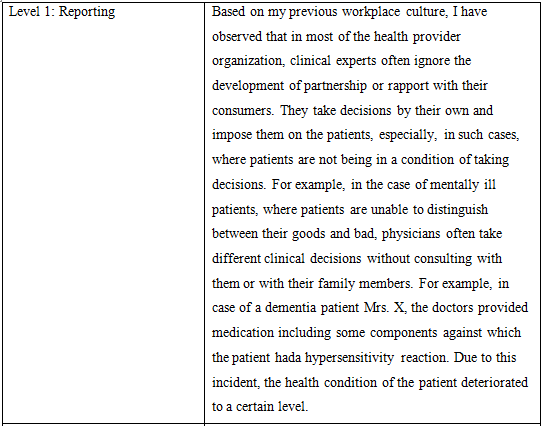
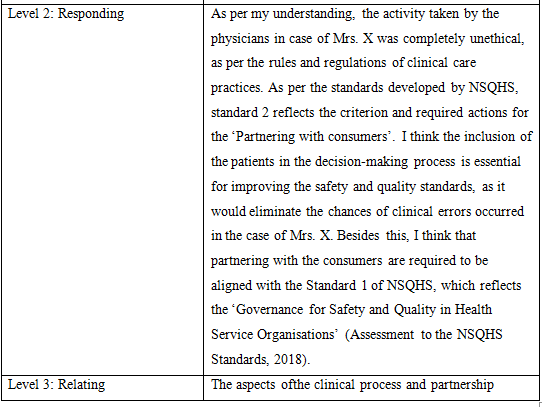
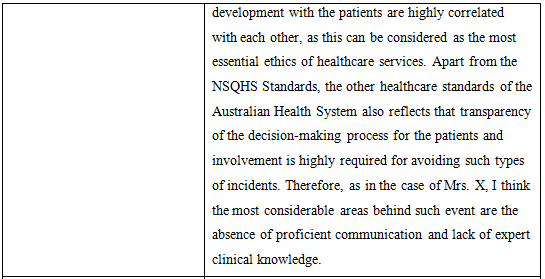
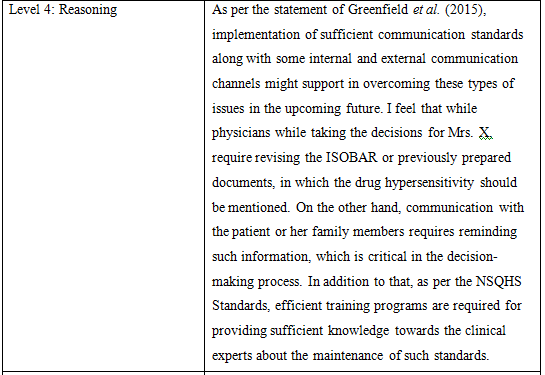
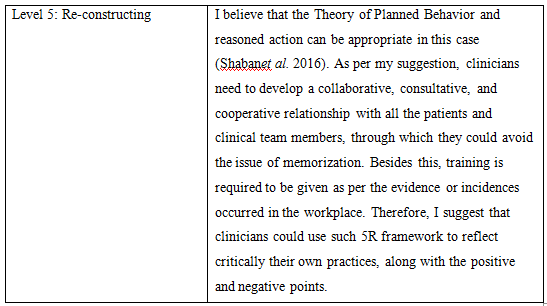
Conclusion
Therefore, based on the entire discussion, it can be stated that NSQHS Standards play critical roles in the formation of Australian Healthcare Systems. Through applying the standards protocols, the clinicians couldtry to avoid medical errors from the treatment programs and improve the ultimate health situations of the patients. However, the effective application of such standards also requires sufficient clinical knowledge, which is required to be updated along with the changing needs of the customers.
Work together with expertsmind’s tutor to achieve success in Importance of National Safety and Quality Health Service Standards in the Australian Health System Assignment Help soluition!